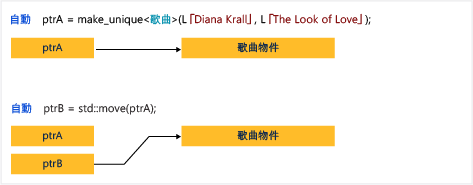如何:建立和使用unique_ptr實例
unique_ptr 不會共用其指標。 它無法複製到另一個 unique_ptr 、以值傳遞至函式,或用於任何需要進行複本的 C++ 標準程式庫演算法中。 只能移動 unique_ptr。 這表示記憶體資源的擁有權轉移到另一個 unique_ptr,原始 unique_ptr 不再擁有它。 因為多重擁有權會增加程序邏輯的複雜度,建議您將物件限制為一個擁有者。 因此,當您需要純 C++ 物件的智慧型指標時,請使用 ,並在建構 unique_ptr 時使用 unique_ptr make_unique 協助程式函式。
下圖說明兩個 unique_ptr 執行個體之間的擁有權轉移。

unique_ptr 定義于 <memory> C++ 標準程式庫的標頭中。 它與原始指標完全相同,而且可用於 C++ 標準程式庫容器。 將實例新增 unique_ptr 至 C++ 標準程式庫容器是有效率的,因為 的移動建構函 unique_ptr 式不需要複製作業。
範例 1
下列範例示範如何建立 unique_ptr 執行個體,並在函式之間傳遞這些執行個體。
unique_ptr<Song> SongFactory(const std::wstring& artist, const std::wstring& title)
{
// Implicit move operation into the variable that stores the result.
return make_unique<Song>(artist, title);
}
void MakeSongs()
{
// Create a new unique_ptr with a new object.
auto song = make_unique<Song>(L"Mr. Children", L"Namonaki Uta");
// Use the unique_ptr.
vector<wstring> titles = { song->title };
// Move raw pointer from one unique_ptr to another.
unique_ptr<Song> song2 = std::move(song);
// Obtain unique_ptr from function that returns by value.
auto song3 = SongFactory(L"Michael Jackson", L"Beat It");
}
這些範例示範 unique_ptr 的這種基本特性:可加以移動,但無法複製。 「移動」會將擁有權轉移到新的 unique_ptr 並重設舊的 unique_ptr。
範例 2
下列範例示範如何建立 unique_ptr 執行個體並在向量中使用這些執行個體。
void SongVector()
{
vector<unique_ptr<Song>> songs;
// Create a few new unique_ptr<Song> instances
// and add them to vector using implicit move semantics.
songs.push_back(make_unique<Song>(L"B'z", L"Juice"));
songs.push_back(make_unique<Song>(L"Namie Amuro", L"Funky Town"));
songs.push_back(make_unique<Song>(L"Kome Kome Club", L"Kimi ga Iru Dake de"));
songs.push_back(make_unique<Song>(L"Ayumi Hamasaki", L"Poker Face"));
// Pass by const reference when possible to avoid copying.
for (const auto& song : songs)
{
wcout << L"Artist: " << song->artist << L" Title: " << song->title << endl;
}
}
在範圍 for 迴圈中,請注意 unique_ptr 是以傳址方式傳遞。 如果您嘗試在這裡以傳值方式傳遞,編譯器就會擲回錯誤,因為 unique_ptr 複製建構函式已刪除。
範例 3
下列範例示範如何初始化本身為類別成員的 unique_ptr。
class MyClass
{
private:
// MyClass owns the unique_ptr.
unique_ptr<ClassFactory> factory;
public:
// Initialize by using make_unique with ClassFactory default constructor.
MyClass() : factory (make_unique<ClassFactory>())
{
}
void MakeClass()
{
factory->DoSomething();
}
};
範例 4
您可以使用 make_unique來建立 unique_ptr 陣列的 ,但無法用來 make_unique 初始化陣列元素。
// Create a unique_ptr to an array of 5 integers.
auto p = make_unique<int[]>(5);
// Initialize the array.
for (int i = 0; i < 5; ++i)
{
p[i] = i;
wcout << p[i] << endl;
}
如需更多範例,請參閱 make_unique 。
另請參閱
意見反應
即將登場:在 2024 年,我們將逐步淘汰 GitHub 問題作為內容的意見反應機制,並將它取代為新的意見反應系統。 如需詳細資訊,請參閱:https://aka.ms/ContentUserFeedback。
提交並檢視相關的意見反應